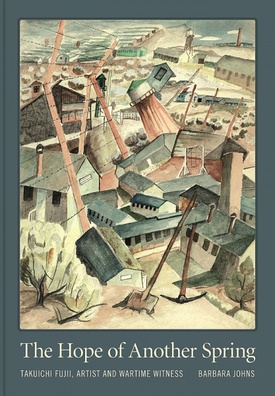This altogether beautiful book by noted Seattle-based art historian and curator Barbara Johns strikingly testifies to the oft-stated judgment that a picture is worth a thousand words. The core of The Hope of Another Spring is the astonishing illustrated diary that Issei Takuichi Fujii (1891-1964) fashioned (almost completely) while incarcerated during World War II with his wife and two daughters at the Puyallup Assembly Center (Washington) and the Minidoka Relocation Center (Idaho) concentration camps.
Described in a discerning foreword by renowned historian Roger Daniels as “the most remarkable document created by a Japanese American prisoner during the wartime incarceration,” the condensed diary in the book consists of a selection of words (translated into English by Fujii’s grandson Sandy Kita with Honda Shojo) and images (inked drawings) amounting to more than half of the record’s total contents.
The Hope of Another Spring is anchored by an authoritative multifaceted introduction by Johns that narrates Fujii’s life history and situates his work into a strategic historical context. It also includes a sampling of radiant watercolor paintings that were outgrowths of Fujii’s inked drawings, Sandy Kita’s movingly personal introduction to his grandfather’s diary, a concise statement by the artist about the aim of his painting, an exhibition history covering Fujii’s artistic career, a useful compilation of endnotes, a carefully selected bibliography of especially pertinent sources, and a well-crafted subject index.
Two things in particular make the book under review very special. First, it marks the initial time that Takuichi Fujii’s World War II illustrated diary and correlated watercolors have been made available for public consumption, enjoyment, and edification. Second, and related, is that as a result of the availability of Fujii’s inmate work, readers as well as researchers are gifted with the fortuitous opportunity of accessing and assessing the unique perspective of a clear-sighted first-generation Nikkei witness to the forced wartime mass incarceration of some 120,000 Japanese Americans.
In reading and viewing the contents of The Hope of Another Spring, a trio of critical concerns need to be taken under earnest advisement: 1) What was the type of diary that Fujii maintained when incarcerated at Puyallup and Minidoka? 2) What sort of witness was Fujii to the wartime imprisonment experience of his racial-ethnic community? and 3) To what extent, if any, did Fujii’s diary constitute an act of resistance to his oppression and that of other confined Japanese Americans? Rather than to disclose my answers to these questions, I will instead simply pose them here as a challenge for the readers-viewers of this remarkable book to ponder and resolve for themselves.
Before even buying or borrowing The Hope of Another Spring, I would strongly recommend that people take the time to first consult the magnificent photo essay that the University of Washington Press has thoughtfully provided for prospective patrons.
The Hope of Another Spring: Takuichi Fujii, Artist and Wartime Witness
By Barbara Johns
(Seattle: University of Washington Press, 2017, 352 pp., $39.95, hardback)
*This article was originally published in the Nichi Bei Weekly on January 1, 2018.
© 2018 Arthur A. Hansen / Nichi Bei Weekly








